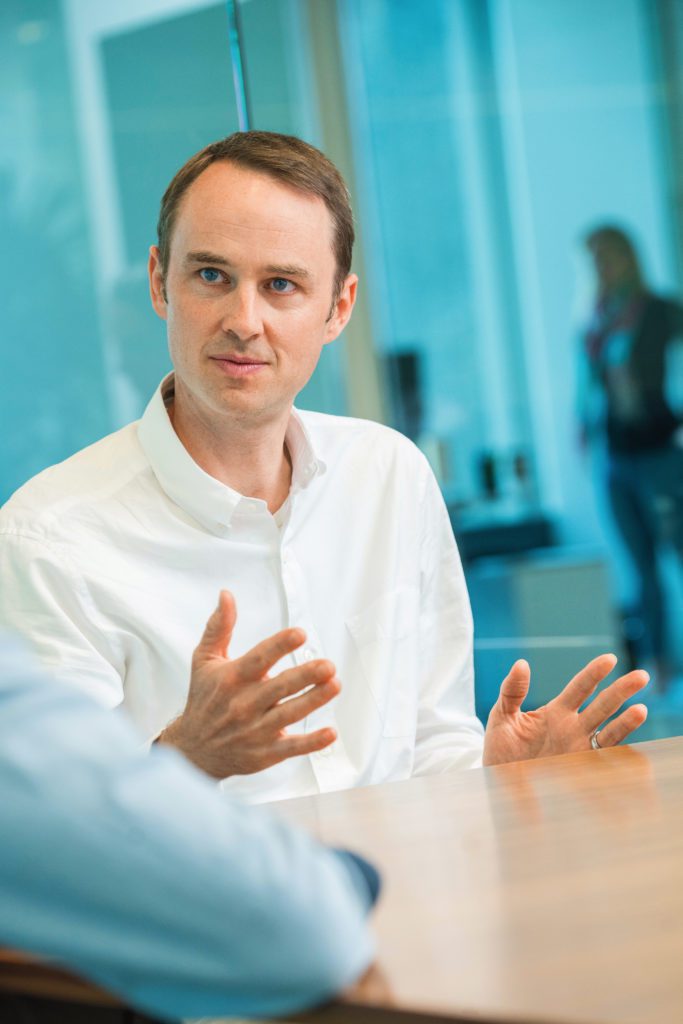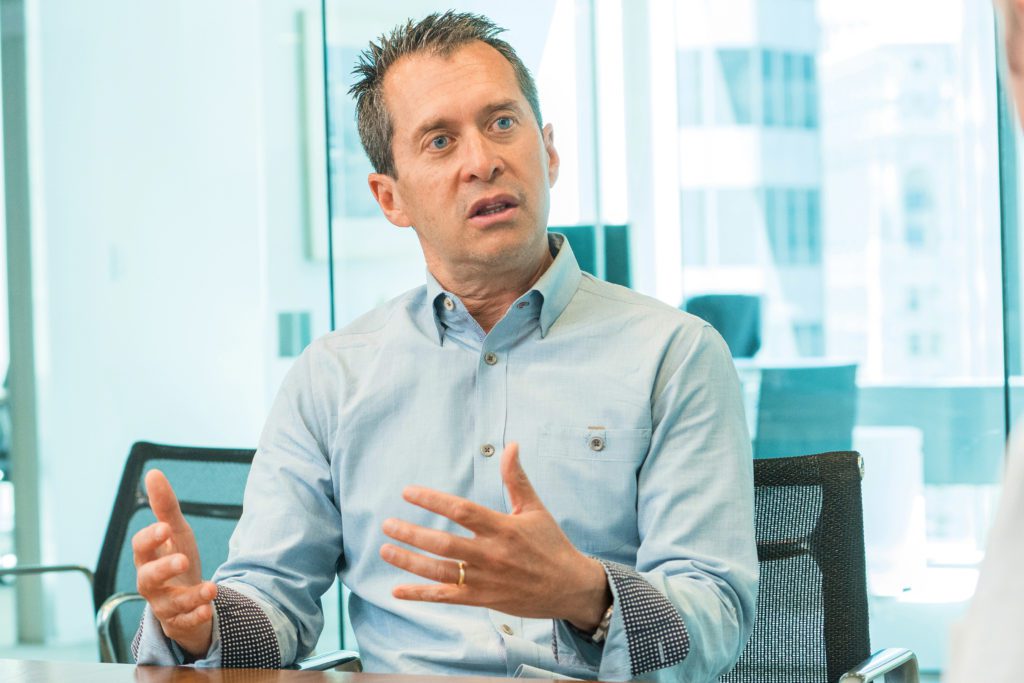Navigating the Start-Up Ecosystem
Professor Abraham Cable and Glen Van Ligten ’91 have been co-teaching the corporate classroom component of the Startup Legal Garage—a program offered by the UC Law SF Institute for Innovation Law—for the past three years. The class is intended to help students who are working with early-stage technology companies across a wide variety of industries, including biotech, mobile, payments, gaming, and identity protection. The students identify issues, engage in legal research, and solve problems for their start-up clients with the guidance of supervising attorneys. Cable and Van Ligten provide a foundation for the students’ client work and run simulations to enrich the students’ overall experience. Here, at the close of the spring term, Cable interviewed Van Ligten about the benefits of hands-on training and discussed Van Ligten’s practice as a partner in Bay Area firm Gunderson Dettmer’s corporate and securities group.
AC: How would you describe your practice at Gunderson Dettmer?
GVL: I represent companies at various stages of financing. I consult with teams of founders, and many of their companies offer software as a service (SAAS). We function as their general counsel if they don’t have someone in-house, and we’ll help them with corporate work and financing strategy, and represent them if they go through a merger or initial public offering. Over the course of a year, I’ll work on hundreds of financing deals for companies and venture capital funds.

Abraham Cable
AC: What are some of the most important ways that lawyers can help entrepreneurs?
GVL: I find that the most important thing is to provide market data and market knowledge. From working with so many companies, we have a better sense of the whole ecosystem. We see the various ways that founders set up their common stock ownership, how they make their vesting policy, and we know the terms for their various rounds of financing. So much of what we do comes down to pattern recognition. If we’ve seen 200 companies get acquired, we know what can happen with the board, with hiring executives, with the typical business terms of the merger. We’re there to help companies look over the horizon and plot their next two or three moves on the chessboard.
AC: Have you noticed any significant developments or changes in the start-up ecosystem recently?
GVL: The climate for funding companies has really changed, especially in earlier-stage financing. Institutional funds used to finance rounds of $200 million to $250 million once a company had proved itself in the market, but now, you’ll see early-stage companies get those sums from venture capital (VC) funds in seed rounds and from angel investors. So that means that companies can delay going to traditional institutional funds for longer than they did in the past. But they also seem to need to spend more before going public than they used to. This could be due to the fact that some of the higher-profile companies need to develop market share rather than develop a particular technological advantage. Acquiring customers is what they spend money on. By having companies wait longer before IPO, they are at a growth stage that would have previously been funded by public stock, but now it is covered by VC funds. The market capitalization expectations of companies going public are much greater than they were before. Ten to 15 years ago, companies were able to go public with market cap of $200 million to $300 million, but now it is much more.
AC: You have witnessed many ups and downs since the late ’90s in the tech market. Where are we now?
GVL: We’re constantly assessing if we are in a healthy fundraising environment or if it’s really frothy, in an overvalued bubble. We have a unique insight because we see every stage of the market, from fundraising to the types of deals that take place when a company is acquired or goes public. VCs are not having problems raising money right now. I am generally a glass-is-half-full kind of guy, yet my gut analysis says that we’re in an unprecedented high point that will taper off, possibly with a correction in 2019
AC: What’s the most important thing about being a lawyer that you did not learn in law school?
GVL: I did not understand the importance of being solutions-oriented until I got out into the working world. There is nothing theoretical. You are coming up with solutions in an imperfect environment in which your clients don’t have a lot of money to spend, and they also don’t have a high tolerance for rigorous legal analysis. You have to mitigate their risk and map a solution to your clients’ business needs while counseling them almost in a therapeutic way. You have to have the ability to read people and understand how they are built, and help them manage a situation as a fully human counselor rather than as a pure legal theoretician.
Traditionally, law schools haven’t been big on teaching people skills, or they weren’t during my time. Yet the truth is that you end up managing people pretty soon after getting your JD, but you don’t learn about supervising or reviewing or giving feedback to co-workers in law school. But the day comes quickly when you’re a third- or fourth-year associate, and you manage first- and second-year associates along with some paralegals and assistants. Some people are good at it; some aren’t, and you just have to learn how to improve along the way.

Glen Van Ligten ’91
AC: On that note, you and I are teaching mostly 3Ls who have been at the law school for a few years. Sometimes, we joke that we are trying to help them unlearn a lot of what they have learned in their first two years of law school. What habits do you think law students have that need reforming?
GVL: We are retraining folks about writing legal memos, for one thing. Of course you have to have an analytical base of knowledge, but how can they reorient it to use it in a practical setting? Clients don’t want suggestions; they want solutions. [Students] have to repackage their learning for a real-world environment.
For example, the rubric that students learn out of the gate in law school is IRAC: issue, rule, analysis, conclusion. That is the way they are supposed to analyze a problem for the bar exam, so it is an emphasis for most law classes. In our class, the final exam is a set of facts and an instruction to propose a solution to a client in a way that is useful. In contrast to most other law classes, we would penalize a student who provided too much legal citation or presented the memo in a way that hid the punchline to the client or was longer than a couple hundred words. We are trying to simulate a real professional relationship. Students need to learn to present their ideas to a client [in a way] that is contained on the first screen of an email read on a smartphone. It’s hard to do this.
AC: After having taught for several years, what are your impressions of UC Law SF students?
GVL: The students are terrific, and they defy the millennial stereotypes. They’re like our firm’s new associates, more capable than I was at that age because they have to perform in a world where people can reach them all the time. They need to get things done in a more compressed time frame than ever before. I had more opportunity to ponder legal issues because it took more time to send work by fax and FedEx, and no one was waiting for your instant reply back then. On the other hand, this generation expects more out of their work environment. They are not willing to accept that when you come into a law firm, it’s OK for things to be the way they are simply because they have been like that forever. That is a challenge for law firm managers, but it is one I think we ought to embrace.